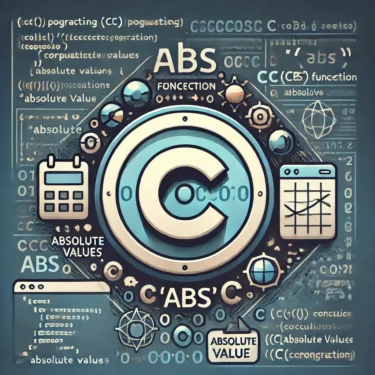1. Introduction
In programming, data structures that improve memory efficiency and handle complex data management are extremely important. The union in the C language is one such data type designed to meet these needs. By using a union, you can reduce memory usage and efficiently manage values of different data types.
Features and Purpose of a Union
A union is a data structure where multiple members share the same memory space. Unlike a structure (struct), which allocates separate memory for each member, a union allows multiple members to share a single memory block. This enables efficient handling of different data types. Unions are often used in environments with limited memory, such as embedded systems, and are also useful in network communication and data packet parsing.
When Unions Are Useful
The main advantage of a union is its ability to “interpret the same memory area in different ways.” For example, in network programming, a data packet may contain various types of information that need to be accessed individually. Using a union allows you to handle one piece of data from multiple perspectives, maintaining both memory efficiency and readability while accessing the necessary data.
Unions are also often used as “tagged unions,” where only one of several possible data types is stored at any given time. This approach reduces memory consumption while managing type information, making it especially effective in situations where memory optimization is critical and multiple data types must be handled within limited memory.
Difference Between Unions and Structures
While unions and structures have similar syntax, they differ greatly in memory usage. In a structure, each member has its own memory space, and changes to one member do not affect others. In a union, all members share the same memory space, so setting a value for one member will affect the others.
2. Basic Syntax and Declaration of Unions
A union in C is a type of data structure in which multiple members of different data types share the same memory space. This section explains the basic syntax and declaration methods for defining and using unions.
Declaring a Union
Unions are declared using the union keyword, similar to structures. The syntax is as follows:
union UnionName {
DataType member1;
DataType member2;
...
};Example: Declaring a Union
The following code declares a union named Example with members of integer, floating-point, and character types:
union Example {
int integer;
float decimal;
char character;
};This union can store either an integer, a floating-point number, or a character at any given time. Since all members share the same memory space, only one value can be held at a time, and the most recently assigned member’s value is the only one that remains valid.
Initializing a Union
To initialize a union variable, use braces { } in the same way as with structures. For example:
union Data {
int id;
float salary;
char name[20];
};
int main() {
union Data data = { .id = 123 };
printf("ID: %d\n", data.id);
return 0;
}In this example, the id member is initialized first. Unions are initialized according to the type of the first specified member, and other members are unaffected.
Accessing Union Members
To access a union’s members, use the dot operator (.) after the variable name to specify the desired member:
Example: Accessing Members
union Data {
int id;
float salary;
char name[20];
};
int main() {
union Data data;
// Access members
data.id = 101;
printf("ID: %d\n", data.id);
data.salary = 50000.50;
printf("Salary: %.2f\n", data.salary);
snprintf(data.name, sizeof(data.name), "Alice");
printf("Name: %s\n", data.name);
return 0;
}Here, each member of the Data union is assigned and displayed. However, since unions share memory, only the value of the most recently assigned member is valid.
Difference in Declaration Between Unions and Structures
Although unions and structures share similar declaration syntax, their memory allocation methods differ significantly. Structures allocate separate memory blocks for each member, while unions share one memory block among all members. As a result, a union’s size is determined by its largest member.
Checking Memory Size
Use the sizeof operator to check a union’s memory size:
#include <stdio.h>
union Data {
int id;
float salary;
char name[20];
};
int main() {
printf("Union size: %zu bytes\n", sizeof(union Data));
return 0;
}In this example, the name member determines the size, which is 20 bytes. The largest member dictates the union’s total memory size, ensuring efficient memory usage.
3. Characteristics of Unions and Memory Management
In C, a union allows multiple members to share the same memory location, which helps minimize memory usage. This section explains the characteristics of unions and how memory management works with them.
How Memory Sharing Works
Although unions have a declaration syntax similar to structures, their memory allocation differs greatly. In a structure, each member has its own independent memory space. In a union, all members share the same memory space. As a result, you cannot store different values in multiple members at the same time—only the value of the most recently assigned member is valid.
Memory Layout Example
For example, in the following Example union, the int, float, and char members all share the same memory space:
union Example {
int integer;
float decimal;
char character;
};The size of this union is determined by the largest member (in this case, either int or float). Other members share this same memory area.
Checking the Size of a Union
You can use the sizeof operator to check the size of a union:
#include <stdio.h>
union Data {
int id;
float salary;
char name[20];
};
int main() {
printf("Union size: %zu bytes\n", sizeof(union Data));
return 0;
}In this example, the name member is the largest (20 bytes), so the total union size is 20 bytes. Other members share this memory, reducing overall memory usage.
Managing Types with Tagged Unions
Because a union allows multiple data types to share the same memory, you need a way to track which type is currently in use. A common approach is the “tagged union,” where a structure contains a union along with a variable (tag) that records the active data type. This improves code readability and reliability.
Example: Tagged Union
#include <stdio.h>
enum Type { INTEGER, FLOAT, STRING };
struct TaggedUnion {
enum Type type;
union {
int intValue;
float floatValue;
char strValue[20];
} data;
};
int main() {
struct TaggedUnion tu;
// Set an integer value
tu.type = INTEGER;
tu.data.intValue = 42;
// Check type before accessing
if (tu.type == INTEGER) {
printf("Integer value: %d\n", tu.data.intValue);
}
return 0;
}In this example, the type tag indicates which member currently holds valid data, preventing accidental access to an incorrect type.
Cautions in Memory Management
When using unions, you must watch out for certain pitfalls, especially the risk of memory overlap causing unexpected behavior. Managing type information correctly is essential.
Risk of Memory Overlap
Because all members share the same memory, setting one member’s value and then reading another’s may result in unpredictable results:
#include <stdio.h>
union Example {
int intValue;
float floatValue;
};
int main() {
union Example example;
example.intValue = 42;
printf("Value as float: %f\n", example.floatValue); // May produce invalid output
return 0;
}This kind of type-punning can lead to corrupted or meaningless values, so you must handle unions with care.
Ensuring Type Safety
Unions do not enforce type safety. It’s up to the programmer to track which type is currently valid. Using a tagged union is the best way to maintain type safety.
Advantages of Using Unions
Unions are highly effective in memory-constrained programming environments. By allowing only one member to occupy the memory space at a time, they are widely used in embedded systems, network communications, and other scenarios where memory efficiency is critical. Proper type management and awareness of memory overlap risks are key to their safe use.

4. Use Cases and Practical Examples of Unions
Unions are particularly useful when memory efficiency is essential. This section introduces real-world use cases and applications of unions. With proper use, unions can help reduce memory usage and improve data management efficiency.
Using Tagged Unions
A tagged union is a strategy to safely manage which data type a union currently holds. By storing a tag along with the union, you can prevent errors and ensure safe data handling.
Example: Tagged Union
#include <stdio.h>
enum DataType { INTEGER, FLOAT, STRING };
struct TaggedData {
enum DataType type;
union {
int intValue;
float floatValue;
char strValue[20];
} data;
};
int main() {
struct TaggedData td;
// Store integer data
td.type = INTEGER;
td.data.intValue = 42;
// Check tag before output
if (td.type == INTEGER) {
printf("Integer data: %d\n", td.data.intValue);
}
return 0;
}Here, the type tag ensures that only the valid member is accessed, allowing safe and effective use of the union.
Packet Parsing in Network Programming
In network programming and communication protocol implementations, you often need to process data packets efficiently. A union lets you store different data formats in the same memory space and interpret them as needed.
Example: Packet Parsing
#include <stdio.h>
union Packet {
struct {
unsigned char header;
unsigned char payload[3];
} parts;
unsigned int fullPacket;
};
int main() {
union Packet packet;
packet.fullPacket = 0xAABBCCDD;
printf("Header: 0x%X\n", packet.parts.header);
printf("Payload: 0x%X 0x%X 0x%X\n", packet.parts.payload[0], packet.parts.payload[1], packet.parts.payload[2]);
return 0;
}This approach allows you to access the same data as a whole packet or as individual parts without wasting memory.
Reinterpreting Memory as Another Data Type
Unions allow you to reinterpret the same memory bytes as a different type. For example, you can read a number as a string of bytes or treat a floating-point number as an integer.
Example: Memory Reinterpretation
#include <stdio.h>
union Converter {
int num;
char bytes[4];
};
int main() {
union Converter converter;
converter.num = 0x12345678;
printf("Byte representation:\n");
for (int i = 0; i < 4; i++) {
printf("Byte %d: 0x%X\n", i, (unsigned char)converter.bytes[i]);
}
return 0;
}Here, an integer is accessed as an array of bytes, demonstrating how unions can facilitate low-level memory manipulation.
Precautions When Using Unions
While unions can optimize memory usage, they come with risks, especially regarding memory overlap and type safety. Always access data using the correct type to avoid unintended results.
5. Precautions and Risk Management When Using Unions
In C programming, a union is a valuable feature for memory-efficient data management, but if used incorrectly, it can lead to unintended behavior. This section highlights important points to watch for and strategies to minimize risks when working with unions.
Risk of Memory Overlap
Because all members of a union share the same memory space, assigning a value to one member and then reading from another can produce unexpected results. This issue is known as memory overlap and is particularly common in unions containing members of different data types.
Example: Memory Overlap
#include <stdio.h>
union Example {
int intValue;
float floatValue;
};
int main() {
union Example example;
example.intValue = 42; // Set as integer
printf("Value as float: %f\n", example.floatValue); // May produce invalid output
return 0;
}In this example, the value assigned to intValue is interpreted as a floating-point number when accessed through floatValue, which often leads to meaningless results. Because unions share memory between different types, careful type management is essential.
Type Safety Issues
Unions do not enforce type safety. It is the programmer’s responsibility to keep track of which member currently holds valid data. Accessing the wrong type can lead to corrupted data, so using strategies to maintain type safety is strongly recommended.
Ensuring Type Safety with Tagged Unions
Tagged unions store an additional variable to indicate the current type of data in the union, helping prevent type errors.
#include <stdio.h>
enum DataType { INTEGER, FLOAT };
struct TaggedUnion {
enum DataType type;
union {
int intValue;
float floatValue;
} data;
};
int main() {
struct TaggedUnion tu;
tu.type = INTEGER;
tu.data.intValue = 42;
if (tu.type == INTEGER) {
printf("Integer value: %d\n", tu.data.intValue);
} else if (tu.type == FLOAT) {
printf("Float value: %f\n", tu.data.floatValue);
}
return 0;
}In this example, the type field specifies which union member is valid, reducing the risk of accessing invalid data.
Debugging Challenges
Debugging code that uses unions can be more difficult because multiple members share the same memory. It can be hard to determine which member currently holds valid data.
Tips to Simplify Debugging
- Check memory state: Inspect the memory layout during debugging to see which member was set most recently.
- Use comments and documentation: Clearly document how each union member should be used, including its purpose and constraints.
- Use tagged unions: Tagged unions make it easier to track the active type and simplify debugging.
Considerations for Memory Management
The size of a union is determined by its largest member, but memory layout and type sizes can differ across platforms. It’s important to avoid platform-dependent behavior when designing portable programs.
Platform Dependency Issues
When working with unions across different platforms, differences in type sizes and memory alignment can lead to unpredictable results. To avoid these issues, understand the specifications of each platform and test your program in multiple environments.
Summary: Safe Use of Unions
- Ensure type safety: Use tagged unions to clearly track the active data type.
- Make debugging easier: Add clear comments and check memory states during debugging.
- Be aware of platform dependencies: Test your program on all target platforms to ensure consistent behavior.
6. Summary and Practical Tips
The union in C is an important data structure for managing different data types while optimizing memory efficiency. This article has covered union declaration, memory management, real-world use cases, and potential pitfalls. This section summarizes key points to keep in mind when working with unions.
Reviewing the Benefits of Unions
The greatest advantage of a union is its ability to store different data types in the same memory space. This reduces memory usage and allows efficient data handling even in resource-limited environments such as embedded systems and network programming. Unions are also useful for specialized purposes like reinterpreting the same byte sequence as different types.
Risk Management and Type Safety
Safe use of unions requires careful management of type safety and awareness of memory overlap risks. Using tagged unions ensures that the currently active data type is always tracked, preventing data corruption. When accessing data as different types, always consider the current memory state and type information.
Practical Tips for Using Unions
- Use tagged unions: Clearly manage which member is active for better type safety and easier debugging.
- Improve debugging and documentation: Because unions can be tricky to debug, include detailed comments and maintain up-to-date documentation.
- Check cross-platform compatibility: When targeting multiple platforms, ensure the union behaves consistently by testing in each environment.
Final Thoughts
Unions can be a powerful tool for data management in memory-constrained environments. From network packet parsing to efficient handling of multiple data types, unions offer significant advantages when used correctly. By understanding their characteristics, applying type safety measures like tagged unions, and being mindful of platform differences, you can fully leverage the benefits of unions in your C programs.





